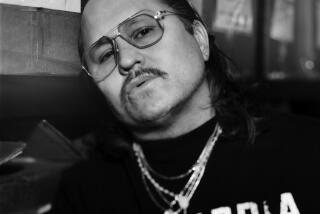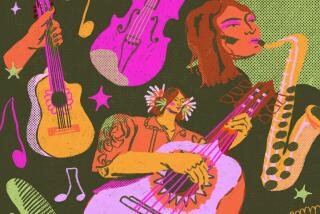Mexican Horsemen : Tailor of Bold Charro Outfits Is a Rare Breed
- Share via
Like countless people in business in Los Angeles--restaurateurs, beauticians, even owners of dry cleaning establishments--Julio Vazquez has a wall in his shop that is filled with autographed photos of stars expressing their gratitude for his services.
But the black-and-white fan glossies on Vazquez’ wall are signed by Spanish-language personalities like Miguel Aceves Mejia, Rodolfo Sanmartin and Pepe Gavilan.
Vazquez is a tailor by trade, one of what is believed to be less than 100 people in the world who call themselves charreros , specialists who design suits exclusively for Mexican charros (horsemen) and mariachis (musicians).
“My family got into this business when my father was a tailor in Tijuana and mariachis started bringing in samples for him to copy,” Vazquez, 42, said. “I began learning how to make the suits 35 years ago when I was small, and I set up this business 10 years ago.”
Business boomed from the start, he said. He estimated that his Boyle Heights shop, Charro Art, makes 25 suits a week, or some 60% of all such suits sold in Los Angeles.
Los Angeles has between 1,000 and 2,000 charros who enjoy rodeo-like competitions on weekends. Charro associations also function as a kind of Mexican equivalent of country or social clubs. When dyed-in-the-wool charros marry, they will often wear a charro suit “de gala,” with elaborate ornamentation in silver. Though the average suit costs $300, Vazquez said, others made with real silver can cost far more.
Albert Mizrachi, the owner of charro outfitter shops in Whittier and El Monte whose charro suits are tailored in Mexico, estimated that the Los Angeles charrero market also extends to another 10,000 charros de banqueta , or bench horsemen who affect charro attire. The biggest clients, he said, are mariachis and particularly amateur singers trying to break into the Mexican singing circuit where such outfits are de rigeur .
The suits themselves are derived from styles first worn in America by early Spanish settlers. Most are adorned with intricate suede designs inspired by friezes found in ancient Aztec ruins, or by more modern cowboy emblems like horseshoes and antlers, Vazquez said.
The most difficult part of the suits to make are the suede designs. Vazquez explained that the designs are first traced onto the back of a piece of fabric. Then, following the design from the reverse side, the tailor stitches a strip of suede to the fabric. He then turns the fabric to the right side, and carefully cuts away the extra suede, leaving an exact replica of the original design.
Several Mexican regions have their own traditional designs. For example, Vazquez said, singers from the norteno , or Mexican border areas, wear jackets with fringe a la American cowboys.
Vazquez has dressed stars for 30 record album covers, from a mini- charro skirt for country singer Chia Canales to a mini- charro outfit for child star “El Charrito Juarense” Danielito Salcedo.
What sort does he prefer himself?
“I don’t wear them,” he answered. “A real charro is something special. He knows how to wear a charro suit. I’m not a real charro . And I don’t want to be a charro de banqueta .”
More to Read
Sign up for Essential California
The most important California stories and recommendations in your inbox every morning.
You may occasionally receive promotional content from the Los Angeles Times.










